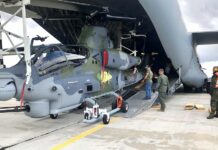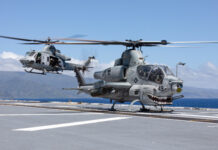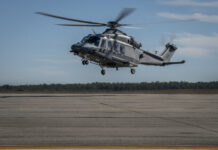Developed and fielded as a result of early US combat experience in Vietnam, the attack helicopter has become a vital tool on the modern battlefield, hunting down and engaging enemy vehicles or even personnel.
Its armament can be a mixture of custom-designed weapons, or existing weapons that have been adapted for the airborne role. These fall into three broad categories – guns, unguided rockets, and guided missiles.
Single-Barrel Weapons
Single-barrel machine guns and cannons use part of the energy released by the exploding cartridge – obtained either by making use of the otherwise-wasted recoil energy or by extracting a small amount of the hot gases from the barrel – to unlock and open the breech, extract the spent case, load a fresh round, close and lock the breech, then release the firing pin in order to explode the cartridge and repeat the entire cycle.
The Eurocopter (now Airbus Helicopters) TIGER HAP (Hélicoptère d’Appui Protection) and HCP (Hélicoptère de Combat Polyvalent) were an early application for the GIAT (now Nexter) THL30 turret system and 30 M781 cannon. The gun is a single-barrelled weapon with a single ammunition feed. On the TIGER installation, the turret contains 450 rounds of
30 x 113B ammunition, and the cannon can be set to fire single shots, bursts of preset length, or continuous fire.
Originally developed to arm the BMP-1 tracked infantry fighting vehicle, the 30mm Shipunov 2A42 cannon was adopted for the Mil Mi-28 and -28N HAVOC, Kamov Ka-50 HOKUM-A and Ka-52 HOKUM-B attack helicopters. Designed by the KBP Instrument Bureau, the 2A42 is a single-barrelled gas-operated weapon that can fire armour-piercing rounds when attacking ground targets, or proximity-fused rounds when attacking enemy helicopters.
On the Mi-28 series, 2A42 is installed in the chin-mounted NPPU-280 turret, but since the Kamov types use a dual-rotor configuration that allows the nose to be positioned independently of the flight vector, the cannon is installed in a semi-rigid mount on the helicopter’s side which allows only a small degree of movement in elevation and azimuth.
While early examples of the Mi-24 HIND-E helicopter had a nose-mounted 12.7mm Yakushev-Borzov YAK-B rotary machine gun, the later Mi-24VP and Mi-35 versions use the GSh-23L cannon. Best known as the weapon installed on many Soviet-era jet fighters such as the MiG-23 FLOGGER and late-model versions of MiG-21 FISHBED, this has two barrels that share a single mechanism which uses the recoil from firing one barrel to load the other.
IST Dynamics’ F-2 cannon turret used to arm the Denel ROOIVALK attack helicopter uses an unusual configuration in that the ammunition bins are mounted on the outside of the aircraft rather than internally – a feature intended to make is easy to integrate the turret onto new types of helicopter such as the Algerian Air Force’s upgraded Mi-24s. It uses a 20mm GI 2 single-barrelled cannon firing at up to 750 rounds per minute.
Rotating Series of Barrels
One weakness of a single-barrel weapon is that if a round of ammunition does not detonate when its primer is initiated, the gun stops firing. This potential unreliability can be avoided by using some form of power-driven breech, and relying on an external source of power for loading and unloading.
The best-known modern example of this approach is the General Electric M61A1 VULCAN cannon carried by many US fighters, each of whose rotating series of barrels is at a different part of the loading/unloading cycle, with the energy needed to turn the barrels and operate the individual breech mechanisms being provided by an electric or hydraulic motor. While one barrel is firing, the others are being progressively loaded and unloaded during the time taken for the entire barrel assembly to make one revolution around its axis.
The most commonly used helicopter armament of this type is the General Dynamics Armament and Technical products M197, a three-barrelled derivative of the VULCAN cannon. Committed to production in 1969, it is used by types that include the modernised AH-1F, the AH-1J SEACOBRA, the AH-1W SUPERCOBRA, and the Agusta A129 MANGUSTA. It has a rate of fire that is selectable, with a maximum of 1,500 rounds per minute.
The Revolver Cannon
In the early 1940s, the Mauser company developed a scheme in which the rotating assembly did not include barrels. A revolving drum allowed a process of loading and unloading similar to that of the VULCAN, but the round was fired only as it became aligned to the weapon’s single barrel.
For its Light Combat Helicopter (LCH), HAL selected the Nexter THL20 turret armed with a 20mm M621 externally-powered revolver cannon. As its designation Tourelle Hélicoptère Leger (THL) indicates, the THL20 was designed to be a lightweight system suitable for use on helicopters destined for the close-support role. The cannon fires 20mm M50 ammunition, which is interchangeable with US M56 rounds.
When engineers from what was then Hughes Helicopters began an independent research and development programme in 1972 with the aim of developing an externally powered single-barrel weapon able to fire the US Army’s existing M50 20mm round, they opted to base their design on a continuous belt of industrial chain of the type commonly used to create drive belts for machinery. This is positioned in a horizontal rectangular track by four sprockets, one of which is powered.
As the chain rotates, a bolt carrier located at one point along its length drags the weapon’s bolt forward toward the breech, pushing a round into the chamber, forcing the bolt face into the breech, and providing the power needed to turn and lock it. As the bolt carrier begins its journey towards the rear of the weapon, it unlocks the breech and extracts the spent case. Once fully rearward, it repeats the cycle for as long as the chain is being power driven. Since this operation cycle is not dependent on variables such as weapon cleanliness, spring tension or gas pressure, the weapon is resistant to the effects of dirt and wear, and is very reliable.
Unguided Rockets
Like guns, unguided rockets can be used when a helicopter is hovering, in forward flight, or in a dive. In the latter two cases, the helicopter’s forward airspeed increases the delivery accuracy. Being relatively simple, rockets are easy to store and handle; and being relatively cheap, can be fired in large numbers.

The standard US Mk 4 2.75 inch (70mm) rocket was not the ideal helicopter weapon. When fired from a high-speed aircraft, the rocket finds itself in a high-speed slipstream when it leaves the launcher, but when fired from a helicopter, it is in a low-speed slipstream and exposed to downwash from the rotor. To get around this problem, the motor nozzle was redesigned into a scarfed form, and the resulting Mk40 motor imparted a degree of spin to the round. While fixed-wing aircraft continued to use the Mk4 rocket, the M40 was used by US Army helicopters.
The US Navy developed a higher-thrust Mk 66 motor which was adopted for tri-service use. It was combined with new launchers and warheads and fielded as the HYDRA 70 weapon system. The HYDRA series is widely-used on Western attack helicopters such as the Boeing AH-64 APACHE, TAI/AgustaWestland T129 ATAK, and various versions of the Bell AH-1 such as the AH-1 SUPERCOBRA, AH-1J SEACOBRA, AH-1W SUPERCOBRA, and Bell AH-1Z VIPER.
For many users, a calibre of around 70mm seems to meet most requirements, so rockets of this type are widely available. Typical examples used on helicopters are the TDA Armament SNEB 68mm rocket and the FZ 70mm rocket. When more explosive is needed on target, one solution was the 5 inch (130 mm) ZUNI rocket. Able to carry a warhead in the 50-60kg class, this can be fired from four-round LAU-10D/A launchers carried by helicopters such as the AH-1J SEACOBRA and AH-1W SUPERCOBRA. However, most users have now phased this weapon out.
Russia has its own patterns of unguided rocket, including the 57mm S-5, 80mm S-8 and 122mm S-13. The heaviest Russian unguided rocket currently in service on attack helicopters is the 240mm S-24.
Reach Out and Touch Someone
A famous late 1970s advertising slogan by a US phone company urged us to ‘reach out and touch someone’. In the world of the attack helicopter, this can best be done at long range by using a guided missile.

The simplest form of guidance that can be used involves transmitting from the launcher to the weapon of steering commands generated by an operator. At first this was done via a trailing wire, but some systems such as the 9M17 PHALANGA (AT-2 SWATTER) carried by early examples of the Mi-24 used a radio command link.
Steering a manually-guided missile was not an easy task, but semi-automatic command to line-of-sight (SACLOS) guidance reduced the operator’s task to that of keeping his sight aligned with the target, while an automatic system tracked the missile and generated the commands needed to keep it on the line-of-sight.
Still used to arm helicopters such as the AH-1W SUPERCOBRA, and the Agusta A129 MANGUSTA, the Raytheon (formerly Hughes) BGM-71 TOW is a classic missile of this type. Although gradually improved over the decades since it was first fielded, receiving the improved warheads and fusing needed to deal with advances in tank armour, it retained wire guidance until wireless versions were introduced in 2012.
Fielded in 1976, the 9K113 SHTURM (AT-6 SPIRAL) became the primary antitank weapon of the Mi-24V and -24P versions of Mil’s well-known attack helicopter. It flies a lofted trajectory so as not to interfere with the tracking sensor of the helicopter’s SACLOS guidance system, but descends onto the sightline during the final approach to the target. Further development of the 9K113 SHTURM led to the 9M120 ATAKA-V (AT-9 SPIRAL-2), which arms the Mi-28 HAVOC and the upgraded Mi-24V and -24P. It also serves on late-model HIND variants including the Mi-24PN, -24PK-2, -24VK-2, as well as the Mi-35M and -35P.
Norinco’s HJ-8 (more recently redesignated as the KD-8) uses wire-based SACLOS guidance. It was originally fielded as a man-portable system, but has been offered for use on CAIC’s Z-10 attack helicopter.
SAL Missiles
Missiles that use semi-active laser guidance are gradually supplanting SACLOS designs. The best-known SAL missile on service aboard attack helicopters is probably the Lockheed Martin/Boeing AGM-114 HELLFIRE. This first entered service in its AGM-114A form for use on the AH-64, but was soon followed by the -114B and -114C variants developed for shipboard use.
A tandem warhead intended to defeat reactive tank armour was introduced by the -114F, while the -114K and -114K2 HELLFIRE II versions introduced an improved seeker and a digital autopilot. Combat experience with HELLFIRE spurred development of the -114M and -114N with blast fragmentation and thermobaric warheads respectively. The -114R added an IMU to the guidance system and introduced a ‘tuneable’ multipurpose warhead.
SAL guidance is also used in weapons such as the Mokopa ATGM offered for use on the Denel ROOIVALK, and the HJ-10 (also known as the AKD-10) carried by the CAIC Z-10. Roketsan uses SAL guidance for its L-UMTAS missile. The KBP Instrument Design Bureau’s HERMES-A is used on the Kamov-52K. A multi-stage missile with a high-powered booster, it uses a combination of radio command and SAL guidance.

SAL guidance is also being used to create high-accuracy versions of existing unguided rockets. A range of designs is currently on offer, most of which add a new nose section combining a SAL seeker and canard control surfaces to off-the-shelf warheads and rocket motors. Current offerings include the BAE System APKWS and the Raytheon and Emirates Advanced Investments TALON, both of which are based on existing HYDRA 70 components. Other candidates include a guided rocket by FZ that incorporates a SAL seeker, IMU and control actuator system, and the ATL/Elbit Guided Advanced Tactical Rocket – Laser (GATR-L). Harbin Jiancheng’s SKY ARROW 90 is a SAL-guided version of the Type 90-1 90mm unguided rocket, but Roketsan’s CIRIT is a custom-designed weapon. MBDA has developed a SAL-guided version of the 5 inch ZUNI rocket.
In 2015 TDA Armaments was awarded a contract to provide its 70mm ACULEUS-LG SAL-guided rocket to France’s Light Army Aviation. After launch, the rocket flies for a few seconds while its nose-mounted seeker searches for a laser-designated target. If laser energy with the correct code is detected, the rocket deploys its canard control surfaces, then begins to correct its course.
Addition of the UGROZA guidance system to Russian S-5, S-8, and S-13 rockets converts these proven Russian weapons to the S-5KOR, S-8KOR, and S-13KOR respectively. The UGROZA upgrade fits the rocket with a SAL-based guidance system, but the method of steering the rocket relies on sideways-firing mini-thrusters rather than aerodynamic control surfaces.

Some missiles use laser beam-riding guidance. The 9K121 VIKHR (AT-16 SCALLION) has four rearward facing detectors that respond to the laser beam transmitted by the launch aircraft, and are likely to prove invulnerable to any tank-mounted EO jamming system. VIKHR has a 10 km range and is armed with a tandem HEAT warhead. Similar in appearance to the laser beam-riding Israeli MAPATS and South African ZT3 INGWE anti-tank missiles, the Norinco HJ-9 (RED ARROW-9) has a maximum range of 5.5 km. The basic version uses laser beam-riding guidance.
KBM’s 9M123 KHRIZANTEMA (AT-15 SPRINGER) was developed for use from helicopters or from ground vehicles. It is known to exist in four variants that use different permutations of guidance (radar or laser-based beam riding) and tandem HEAT or thermobaric warheads.
Fire-and-Forget Missiles
In many ways, the ‘ultimate’ weapon for an attack helicopter is the fire-and-forget missile in which an EO or IIR seeker can be locked onto the image of a distant target, and the missile fired and allowed to home onto its victim with no further action being needed by the operator.

PARSYS PARS 3 LR (originally LR-TRIGAT) was Europe’s first IIR fire-and-forget missile. Development of this 6 km range weapon started in 1988 but was not completed until 2001, by which time France and the UK had lost interest in the system. As a result, it was adopted only by Germany for its Tiger UHT helicopter
Originally known as the NT-Dandy or NT-D, Rafael’s Spike-ER (Extended Range) has a maximum range of 8 km. It is compatible with the TIGER, AW129 MANGUSTA, TAI/AgustaWestland T129 ATAK, and the SUPER COBRA. The addition of a new RF datalink extends the range of the SPIKE ER2 variant to 16 km. Its seeker combines high-resolution IR and day sensors, and the operator can switch from one to the other while the missile is in flight, a feature that could help with the detection of camouflaged targets. A tandem HEAT warhead is intended to cope with the armour of all known MBTs and provide an anti-structure capability, but an alternative Penetration, Blast, and Fragmentation (PBF) warhead is available for use against strongly-fortified positions.
Spike NLOS gives attack helicopters an even more impressive reach; in September 2018 Israel conducted a trial in the Negev Desert during which an Israeli AH-64 APACHE used a SPIKE NLOS missile to strike a target more than 50 km away. Roketsan’s MIZRAK-U (previously known as UMTAS) uses a two-way RF datalink provides communications with the launch platform, and an IIR seeker offering lock-on before launch and lock-on after launch attack modes.
India’s Bharat Dynamics’ HELINA is a helicopter-mounted version of the NAG fire-and-forget missile. This is equipped with a 8-12 micron cadmium mercury telluride seeker and a tandem HEAT warhead, but has suffered from a protracted development programme. Development started in 1988, and test firings started in 1990. Although the Indian MoD claimed in 2006 that development had been completed, this statement proved premature. Final user trials of NAG are due to begin in the summer of 2019, allowing the system to enter production at the end of the year. The HELINA version will equip HAL’s Light Combat Helicopter (LCH).
With the arrival of the AH-64D and its mast-mounted AN/APG-78 millimetric-wave radar also came the AGM-114L LONGBOW HELLFIRE, which was essentially a HELLFIRE II with a nose-mounted Ka-band active radar seeker. There have been no recent reports of progress with a planned millimetric-wave version of HELINA, but China’s HJ-9A follow-on to the laser beam-riding HJ-9 is known to use semi-active millimetre wave radar guidance.

Some attack helicopters are equipped with air-to-air missiles, either for self-protection or as a weapon for use when attacking enemy helicopters. In most cases, an existing air-to-air missile such as the AIM-9 SIDEWINDER or VYMPEL R-73 (AA-11 ARCHER) is carried, but a more common solution is a man-portable surface-to-air missile such as STINGER, MISTRAL, FN-6 and QW series. China’s TY-90 air-to-air missile was custom-designed for helicopter use. This IR-homing weapon weighs only 20 kg, and has a range of 6 km. It initially entered service on Z-9W and -9A licence-built versions of the Eurocopter DAUPHIN, but now arms the Z-10 attack helicopter.
Following an earlier career in engineering, Doug Richardson is a defence journalist specialising in topics such as aircraft, missiles, and military electronics.











